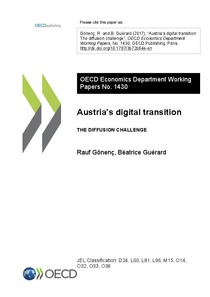Austria’s digital transition. The diffusion challenge
"Austria’s transition to a digital economy and society is slower than in other high-income small open European economies. The rate and pace of utilisation of eight main ICT applications shows that Austrian firms follow peer country counterparts with a gap, which has widened in most areas in rec...
| Main Authors: | , |
|---|---|
| Institution: | ETUI-European Trade Union Institute |
| Format: | TEXT |
| Language: | English |
| Published: |
Paris
2017
OECD |
| Subjects: | |
| Online Access: | https://www.labourline.org/KENTIKA-19396013124911142959-austria’s-digital-transition.-.htm |
| Summary: | "Austria’s transition to a digital economy and society is slower than in other high-income small open European economies. The rate and pace of utilisation of eight main ICT applications shows that Austrian firms follow peer country counterparts with a gap, which has widened in most areas in recent years. Two dynamics drive digital transitions and Austria has room for progress in both of them. First, the potential for digitalisation in all firms, and especially in the smaller ones (where gaps are largest) should be freed-up by upgrading the full range of ICT-generic, ICT-specific and ICT-complementary skills. Second, Austria needs to make its business environment more conducive to firm entry and exit. The rate of entry of new firms and their growth are crucial for the diffusion of new business models and ICT innovations but fall behind peer countries. The adoption of ICT innovations by households also follows a staggered path: young and highly educated Austrians adopt ICT applications in similar ways to their counterparts in peer countries, while middle and older age cohorts display noticeable gaps. This calls for policies to help lagging groups become more acquainted with innovations. A whole-of-government approach, including large-scale utilisation of e-government applications in enterprises and households, should help to embrace change and facilitate the flourishing of innovative businesses, work practices and lifestyles throughout Austria." |
|---|---|
| Physical Description: | 44 p. Digital |

